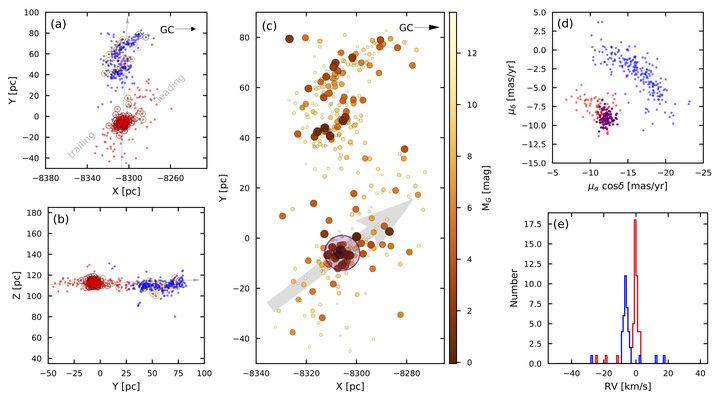Discovery of Tidal Tails in Disrupting Open Clusters: Coma Berenices and a Neighbor Stellar Group
 Image credit: Tang et al. 2019. 3D spatial, PM, and RV plot for Coma Ber & Group-X.
Image credit: Tang et al. 2019. 3D spatial, PM, and RV plot for Coma Ber & Group-X.
Abstract
We report the discovery of tidal structures around the intermediate-aged ($\sim$ 700–800Myr), nearby ($\sim85$pc) star cluster Coma Berenices. The spatial and kinematic grouping of stars is determined with the it Gaia/DR2 parallax and proper motion data, by a clustering analysis tool, StarGO, to map 5D parameters ($X, Y, Z$, $\mu_\alpha \cos\delta, \mu_\delta$) onto a 2D neural network. A leading and a trailing tails, each with an extension of $\sim50$pc are revealed for the first time around this disrupting star cluster. The cluster members, totaling to ~$115^{+5}{-3}$ M${\odot}$, are clearly mass segregated, and exhibit a flat mass function with $\alpha \sim 0.79\pm0.16$, in the sense of $dN/dm \propto m^{-\alpha}$, where $N$ is the number of member stars and $m$ is stellar mass, in the mass range of $m=0.25$–$2.51$ M$_{\odot}$. Within the tidal radius of $\sim$6.9pc, there are 77 member candidates with an average position, i.e., as the cluster center, of R.A.=186.8110 deg, and decl.=25.8112 deg, and an average distance of 85.8pc. Additional 120 member candidates reside in the tidal structures, i.e., outnumbering those in the cluster core. The expansion of escaping members lead to an anisotropy in the velocity field of the tidal tails. Our analysis also serendipitously uncovers an adjacent stellar group, part of which has been cataloged in the literature. We identify 218 member candidates, 10 times more than previously known. This star group is some 65pc away from, and $\sim400$Myr younger than, Coma Ber, but is already at the final stage of disruption.